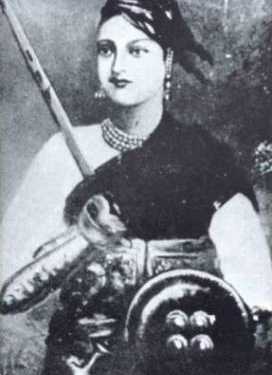The year was 1836. It was early April. Bithoor, a small town near Kanpur, was already beginning to feel the heat of a cruel summer. Two young girls of about eight were staring longingly at a round mango hanging high up in a tree.One of them said, ‘Kashi, you wait here. I will climb the tree and pluck the mango’.
‘No, no Manu, you cannot climb the tree. What will your Baba say?’
‘And why can’t I climb the tree?’ Manu asked, her dark eyes flashing with anger.
‘Girls are not supposed to climb trees Manu. That is a boy’s job. Let us call Nana. Kashi replied.
Manu tossed her head dismissively and said, ‘I can do everything that Nana can do. I can ride a horse better than him in fact. Even his father, Bajiraosaheb says so.’
Manu folded her Parkar (floor length skirt) around itself and tucked its end at the back, turning it into a trouser of sorts and started climbing the tree with great agility.
The aged exiled Peshwa, Bajirao II, was watching the girls from the balcony of his palace. He smiled indulgently. Manu or Manikarnika, was the daughter of his palace clerk, Moropant Tambe. The Peshwa loved her like his own daughter and had made sure that she attended all the classes that his adopted son, Nana Saheb took. Manu’s lessons included archery, horsemanship, and self-defence. The Peshwa fondly called her Chabili – the playful one.
When Manu was about ten, her father moved to Jhansi in the service of the Newalkars, the ruling family of Jhansi. In 1842, Manu was married to the Maharaja of Jhansi, Gangadhar Rao, a man considerably older than her. She was only 14 year old at the time. Young Manu became Laxmibai, the Rani of Jhansi after marriage.
Laxmibai and Gangadhar Rao had a son, Damodar Rao in 1851. However, the child did not live long. Laxmibai and Gangadhar Rao were consumed with grief at his untimely death. The king was old and sick and Jhansi was anxious for an heir.
As the Maharaja’s health deteriorated, he and Laxmibai decided to adopt a son, so that the throne of Jhansi could have a legitimate heir. Gangadhar Rao and Laxmibai adopted a boy named Anand Rao in an elaborate ceremony attended by the British Resident of Jhansi. The child was renamed Damodar Rao. Gangadhar Rao handed over a signed letter to the British Resident stating that Damodar Rao was his legal heir and Rani Laxmibai would rule Jhansi till he came of age. The British Resident had agreed that the adoption was legal.
The very next day, Gangadhar Rao died. Soon after his death, Governor-General Lord Dalhousie, applied the Doctrine of Lapse to Jhansi, rejecting Damodar Rao’s claim to the throne. The state of Jhansi and all its territories were forcibly annexed by the East India Company by deceit. Rani Lakshmibai consulted a British lawyer and filed an appeal for her case in London. But, her plea was rejected. In March 1854, Lakshmibai was offered a pension of Rs. 60,000 and asked to leave the fort. However, the Rani refused to comply.
Rani Laxmibai continued to stay in the fort of Jhansi. She used the time to strengthen the defenses of her fort. She assembled a volunteer army. She also led a crack women’s regiment. Laxmibai’s army was led by warriors like Gulam Gaus Khan, Dost Khan, Khuda Baksh, Lala Bhau Bakshi, Moti Bai, Sunder-Mundar, Kashi Bai, Deewan Raghunath Singh and Deewan Jawahar Singh.
While the Rani was preparing for the battle, on May 10, 1857 an Indian soldier called Mangal Pandey shot dead an English sergeant in Meerut. This incident became the starting point for the rebellion against the British.
The first war of Indian Independence of 1857 had begun.
During this period, the British were busy battling the rebels and Rani Laxmibai was left in peace. Lakshmi Bai managed to keep Jhansi relatively calm. She ruled her state with an iron hand. She was an excellent administrator and the people of Jhansi loved their spirited queen.
Rani Laxmibai had been initially hesitant to openly rebel against the British. Her hand was forced when British troops under Sir Hugh Rose laid siege to Jhansi on 23rd March 1858. Laxmibai conferred with her supporters and decided not to surrender. ‘ Meri Jhansi Nahi Doongi’, she thundered.
Rani Laxmibai fought bravely against the British. The fighting continued for about two weeks. Shelling on Jhansi was very fierce. Laxmibai led from the front, dressed in combat clothes and armed with a sword and a shield. By this time, her childhood friend, Nana Saheb Peshwa was crowned as the leader by the rebels. He sent a massive army of 20,000, led by Tatya Tope, to aid Lakshmi Bai.
However, the British forces were better trained and disciplined. They also had access to better arms and ammunition. The rebel army led by Tatya Tope soon retreated. Rani Lakshmi Bai’s forces were left alone to defend against the siege. The army of Jhansi could not hold out for long and the British were able to breach the city walls and capture the city in just three days!
The brave Rani of Jhansi, however, refused to accept defeat. She planned a daring escape that has now become the stuff of legends. Rani Laxmibai jumped over the fort in the dead of the night, surrounded by her guards. She had her baby, Damodar Rao, tied to her back as she jumped off the fort wall on her favorite horse, Badal.
Rani Laxmibai escaped to Kalpi, a city located some 100 km. from Jhansi traveling through the night. In Kalpi, she joined the rebel forces led by Tatya Tope. Together, they moved to Gwalior, where the combined rebel forces defeated the army of the Maharaja of Gwalior, who was allied with the British forces. The rebels then occupied the fort of Gwalior.
However, the British forces, led by Sir Hugh Rose launched a second attack on the city of Gwalior. Rani Lakshmibai, the Queen of Jhansi, fought bravely against the British forces dressed as a cavalry soldier. She was badly wounded by the British bullets and succumbed to her injuries on 18th of June, 1858. Her close associates cremated her body hurriedly, respecting the Rani’s wish that the British must never capture her, dead or alive!
The British captured the city of Gwalior after three days. In his report Sir Hugh Rose commented that Rani Lakshmibai was “personable, clever and beautiful” and she was “the most dangerous of all Indian rebel leaders.”
The valiant Rani of Jhansi continues to inspire generations of young Indians with her tales of valor. The Rani’s story has been made immortal in the following words of Subhadra Kumari Chauhan:
रानी गई सिधार चिता अब उसकी दिव्य सवारी थी,
मिला तेज से तेज, तेज की वह सच्ची अधिकारी थी,
अभी उम्र कुल तेइस की थी, मनुज नहीं अवतारी थी,
हमको जीवित करने आयी बन स्वतंत्रता-नारी थी,
दिखा गई पथ, सिखा गई हमको जो सीख सिखानी थी,
बुंदेले हरबोलों के मुँह हमने सुनी कहानी थी,
खूब लड़ी मर्दानी वह तो झाँसी वाली रानी थी।।
जाओ रानी याद रखेंगे ये कृतज्ञ भारतवासी,
यह तेरा बलिदान जगावेगा स्वतंत्रता अविनासी,
होवे चुप इतिहास, लगे सच्चाई को चाहे फाँसी,
हो मदमाती विजय, मिटा दे गोलों से चाहे झाँसी।
तेरा स्मारक तू ही होगी, तू खुद अमिट निशानी थी,
बुंदेले हरबोलों के मुँह हमने सुनी कहानी थी,
खूब लड़ी मर्दानी वह तो झाँसी वाली रानी थी।।






























